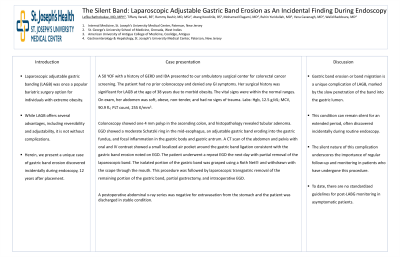Tuesday Poster Session
Category: Stomach
P5105 - The Silent Band: Laparoscopic Adjustable Gastric Band Erosion as an Incidental Finding During Endoscopy
Tuesday, October 29, 2024
10:30 AM - 4:00 PM ET
Location: Exhibit Hall E

Has Audio

Lefika Bathobakae, MD
St. Joseph's University Medical Center
Paterson, NJ
Presenting Author(s)
Lefika Bathobakae, MD1, Tiffany Varadi, BS2, Rammy Bashir, MD2, Atang Koodirile, BS3, Ruhin Yuridullah, MD4, Kamal Amer, MD5, Yana Cavanagh, MD5
1St. Joseph's University Medical Center, Paterson, NJ; 2St. George’s University School of Medicine, Grenada, West Indies, Paterson, NJ; 3American University of Antigua College of Medicine, Coolidge, Antigua, Paterson, NJ; 4St. Joseph’s University Medical Center, Paterson, NJ; 5St. Joseph's University Medical Center, Paterson, NJ
Introduction: Laparoscopic adjustable gastric banding (LAGB) was once a popular bariatric surgery option for individuals with extreme obesity. While LAGB offers several advantages, including reversibility and adjustability, it is not without complications. Herein, we present a unique case of gastric band erosion discovered incidentally during endoscopy, 12 years after placement.
Case Description/Methods: A 50-year-old female with a history of GERD and IDA presented to our ambulatory surgical center for colorectal cancer screening. The patient had no prior colonoscopy and denied any GI symptoms. Her surgical history was significant for LAGB at the age of 38 years due to morbid obesity. The vital signs were within the normal ranges. On exam, her abdomen was soft, obese, non-tender, and had no signs of trauma. Labs: Hgb, 12.5 g/dL; MCV, 90.9 fL; PLT count, 255 K/mm3.
Colonoscopy showed one 4 mm polyp in the ascending colon, and histopathology revealed tubular adenoma. EGD showed a moderate Schatzki ring in the mid-esophagus, an adjustable gastric band eroding into the gastric fundus, and focal inflammation in the gastric body and gastric antrum. A CT scan of the abdomen and pelvis with oral and IV contrast showed a small localized air pocket around the gastric band ligation consistent with the gastric band erosion noted on EGD. The patient underwent a repeat EGD the next day with partial removal of the laparoscopic band. The isolated portion of the gastric band was grasped using a Roth NetÒ and withdrawn with the scope through the mouth (Figure 1). This procedure was followed by laparoscopic transgastric removal of the remaining portion of the gastric band, partial gastrectomy, and intraoperative EGD.
A postoperative abdominal x-ray series was negative for extravasation from the stomach and the patient was disccharged in stable condition.
Discussion: Gastric band erosion or band migration is a unique complication of LAGB, marked by the slow penetration of the band into the gastric lumen. This condition can remain silent for an extended period, often discovered incidentally during routine endoscopy. The silent nature of this complication underscores the importance of regular follow-up and monitoring in patients who have undergone this procedure. To date, there are no standardized guidelines for post-LABG monitoring in asymptomatic patients.

Disclosures:
Lefika Bathobakae, MD1, Tiffany Varadi, BS2, Rammy Bashir, MD2, Atang Koodirile, BS3, Ruhin Yuridullah, MD4, Kamal Amer, MD5, Yana Cavanagh, MD5. P5105 - The Silent Band: Laparoscopic Adjustable Gastric Band Erosion as an Incidental Finding During Endoscopy, ACG 2024 Annual Scientific Meeting Abstracts. Philadelphia, PA: American College of Gastroenterology.
1St. Joseph's University Medical Center, Paterson, NJ; 2St. George’s University School of Medicine, Grenada, West Indies, Paterson, NJ; 3American University of Antigua College of Medicine, Coolidge, Antigua, Paterson, NJ; 4St. Joseph’s University Medical Center, Paterson, NJ; 5St. Joseph's University Medical Center, Paterson, NJ
Introduction: Laparoscopic adjustable gastric banding (LAGB) was once a popular bariatric surgery option for individuals with extreme obesity. While LAGB offers several advantages, including reversibility and adjustability, it is not without complications. Herein, we present a unique case of gastric band erosion discovered incidentally during endoscopy, 12 years after placement.
Case Description/Methods: A 50-year-old female with a history of GERD and IDA presented to our ambulatory surgical center for colorectal cancer screening. The patient had no prior colonoscopy and denied any GI symptoms. Her surgical history was significant for LAGB at the age of 38 years due to morbid obesity. The vital signs were within the normal ranges. On exam, her abdomen was soft, obese, non-tender, and had no signs of trauma. Labs: Hgb, 12.5 g/dL; MCV, 90.9 fL; PLT count, 255 K/mm3.
Colonoscopy showed one 4 mm polyp in the ascending colon, and histopathology revealed tubular adenoma. EGD showed a moderate Schatzki ring in the mid-esophagus, an adjustable gastric band eroding into the gastric fundus, and focal inflammation in the gastric body and gastric antrum. A CT scan of the abdomen and pelvis with oral and IV contrast showed a small localized air pocket around the gastric band ligation consistent with the gastric band erosion noted on EGD. The patient underwent a repeat EGD the next day with partial removal of the laparoscopic band. The isolated portion of the gastric band was grasped using a Roth NetÒ and withdrawn with the scope through the mouth (Figure 1). This procedure was followed by laparoscopic transgastric removal of the remaining portion of the gastric band, partial gastrectomy, and intraoperative EGD.
A postoperative abdominal x-ray series was negative for extravasation from the stomach and the patient was disccharged in stable condition.
Discussion: Gastric band erosion or band migration is a unique complication of LAGB, marked by the slow penetration of the band into the gastric lumen. This condition can remain silent for an extended period, often discovered incidentally during routine endoscopy. The silent nature of this complication underscores the importance of regular follow-up and monitoring in patients who have undergone this procedure. To date, there are no standardized guidelines for post-LABG monitoring in asymptomatic patients.

Figure: Figure 1. Endoscopic images showing an eroded gastric band, which was partially removed endoscopically. There was edema, erosion, and inflammation at the cardia (yellow arrows); however, there was no overt luminal discontinuity.
Disclosures:
Lefika Bathobakae indicated no relevant financial relationships.
Tiffany Varadi indicated no relevant financial relationships.
Rammy Bashir indicated no relevant financial relationships.
Atang Koodirile indicated no relevant financial relationships.
Ruhin Yuridullah indicated no relevant financial relationships.
Kamal Amer indicated no relevant financial relationships.
Yana Cavanagh indicated no relevant financial relationships.
Lefika Bathobakae, MD1, Tiffany Varadi, BS2, Rammy Bashir, MD2, Atang Koodirile, BS3, Ruhin Yuridullah, MD4, Kamal Amer, MD5, Yana Cavanagh, MD5. P5105 - The Silent Band: Laparoscopic Adjustable Gastric Band Erosion as an Incidental Finding During Endoscopy, ACG 2024 Annual Scientific Meeting Abstracts. Philadelphia, PA: American College of Gastroenterology.
